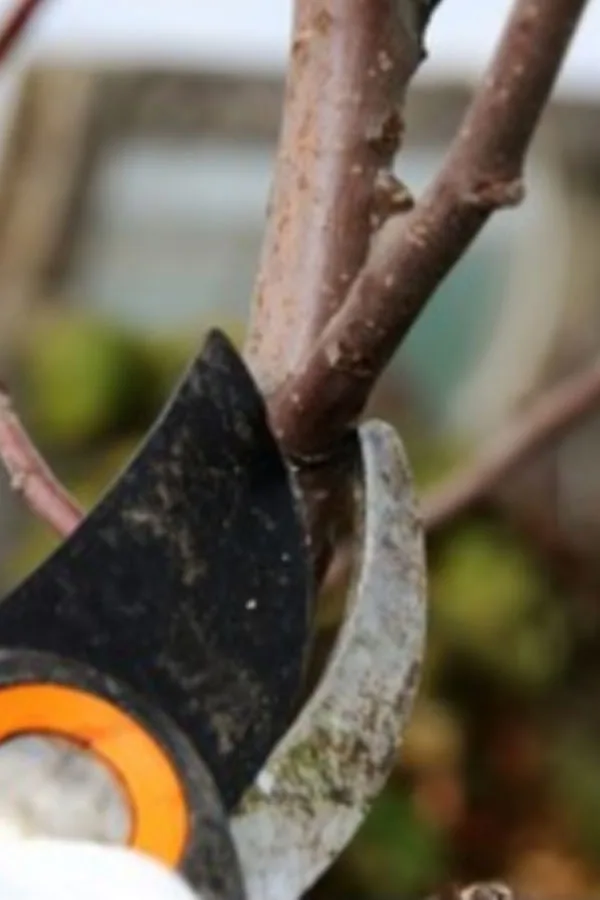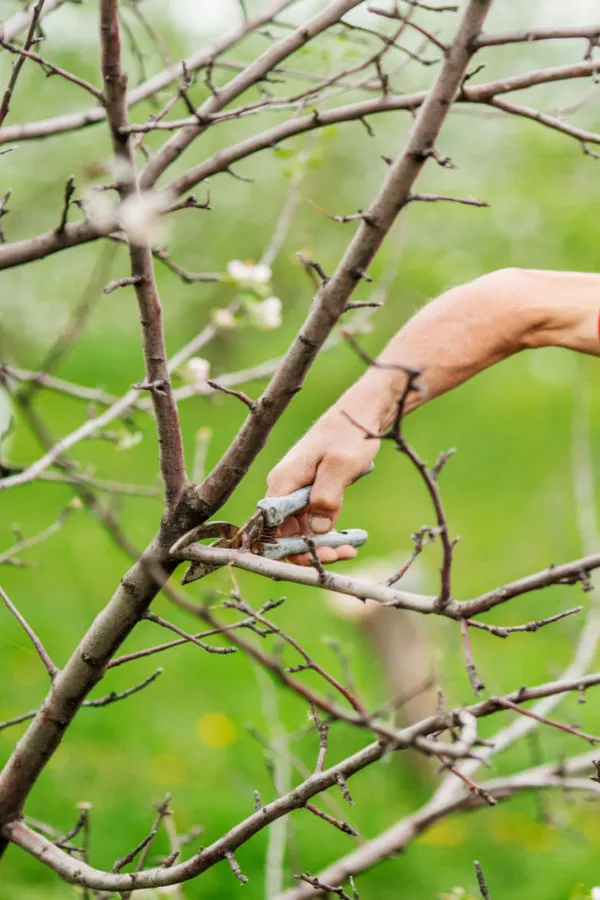There is no better time than in the cold of winter to prune your apple trees. As you will see in today’s article, not only is it less stressful on your apple trees, it also makes the process incredibly simple and uncomplicated.
Pruning all fruit trees on a regular basis is extremely important for their health and productivity. But that is especially true when it comes to apple trees!
When the branches of an apple tree continue to grow at will, they form together into an intertwined mess of limbs. And even though it might seem thick, heavy growth would be good for a tree’s overall health, it actually is quite counter-productive for an apple tree.
For starters, all of that growth can block much needed sunlight and air circulation to the interior of the tree. Both of which are important for drying the tree’s foliage after heavy rains and morning dew. And drying off excess moisture is extremely important when it comes to keeping mildew, mold and other apple tree ailments at bay.
More Reasons To Keep Your Apple Trees In Shape – How To Prune Apple Trees
A thick overgrown canopy of foliage can also be tough on an apple tree’s productivity. Instead of using its resources to help create quality blooms and ripen fruit, the trees energy is spent on maintaining excess limbs and leaves.
Even more, all of that excess growth usually affects the quality of the fruit as well. With so many of the tree’s resources supporting pure growth, the fruit that does form is often undersized and underdeveloped. Worse yet, it is also more prone to creating apples with a large amount of deformities.
But perhaps most important of all, overgrown apple trees often become weak trees with weak limbs. Limbs that have difficulty standing up to tough weather conditions, or to a heavy fruit load in late summer. Unfortunately, that usually leads to trees that damage or die out long before they should.

But the good news is that keeping your apple trees in shape is easier than you might think. In fact, armed with just a few key pruning techniques and tips, you can keep your trees productive and manageable with just an hour or two of work.
Winter Pruning – Why To Prune Apple Trees When They Are Dormant
The first and most important tip starts with knowing when to prune your trees – and when not to!
For best results, always prune your trees in late winter. Although fall is a great time for cutting back most perennials, it’s not the case for apple trees. Pruning stimulates new growth. And if temperatures warm in the fall or stay moderate for long, the trees can start to produce new wood.
Unfortunately, that new wood is extremely vulnerable to winter’s cold. As are all of the pruning cuts that if made in the fall, can’t heal properly before winter’s cold settles in.

But once winter arrives in full force, apple trees go completely dormant. That means that pruning cuts can’t harm the plant, and there is no chance for new growth until spring. Even more, with all of the foliage gone, seeing where to make the cuts is easier than ever as well.
How To Prune Apple Trees In The Winter
Pruning your apple trees correctly in the winter comes down to following three stages of cuts:
- Removing Damaged Limbs & Branches
- Thinning Cuts To Open Up The Middle
- Cutting Back Growth / Shaping
Before we get into pruning, let’s first cover a few pruning basics. Whether using a pruning saw or small chainsaw for larger limbs, pruning loppers for mid-size limbs, or a small pair of hand held pruners for small cuts – always make sure they are sharp and clean!
Sharp blades leave clean cuts that heal quickly. Old, worn blades can tear the wood and damage it in the process. In addition, always clean blades prior to use and in between trees. One of the easiest ways to transfer disease is with cutting tools. A basic bleach wipe is perfect for disinfecting your pruners quickly.
As an extra note, when making any pruning cuts, always make your cut flush to the limb or trunk you are cutting back to. Not only will a flush cut eliminate the chance of a new offshoot forming from a nub, it also keeps the tree strong, eliminating weak offshoots from growing off of partial limbs.

One tool that has been a life-saver for all of our pruning jobs around the farm is our Saker Mini-Chain Saw. Lightweight and battery operated, it makes cutting in tight spaces and cutting flush quick and easy. It is especially great for those who suffer from arthritis or weak hands that struggle to use traditional pruners. Affiliate Product Link: Saker Mini-Chain Saw
Now let’s take a look at the three types of pruning cuts needed to keep your apple trees in shape.
Step 1) Removing Damaged Limbs & Branches – How To Prune Apple Trees In The Winter
For starters, remove any branches or limbs that show signs of damage or disease. Damaged wood on an apple tree (or any tree for that matter) is a drain on the tree’s energy and resources. By their very nature, all plants expend energy trying to heal injuries. But by removing the damaged or diseased wood, you help the tree to stop wasting its resources on the limb and conserve its energy.
Step 2) Thinning Cuts To Open Up The Middle – How To Prune Apple Trees
Once any damaged wood has been removed, it’s time to thin out your apple tree. This is the most important for allowing light and air into the center of the tree.
Next, remove branches that are growing down or straight out horizontally from the tree. Apples are heavy, especially as they mature. Unfortunately, branches that grow out or down cannot hold the fruit. Instead leave only branches that grow in an upward direction as they can hold the weight of fruit.
Finish thinning by cutting off any branches that overlap each other. Of the two that intersect, cut back the thinner or weaker of the two. Continue thinning out the center so that the interior branches all have their own space and are not crowded.
Step 3) Cutting Back Growth / Shaping – How To Prune Apple Trees In The Winter
The third and final step of pruning is all about shaping the tree and cutting back the previous year’s growth a bit. This keeps the tree easier to maintain and also helps to conserve nutrients for apple production.
New wood that grew the previous year is easy to identify. It will be far lighter in color with less bark. To prune back, cut back 1/4th to 1/3rd of the previous year’s growth. This keeps the fruit production more to the center of the tree on wood that is a bit stronger and thicker.
And that’s it – your tree is ready to grow! For more on planting apple trees, be sure to check out our article How To Plant Apple Trees! The Simple Secrets To Growing Apples.
Here is to pruning your apple trees this winter – and to having healthier, more productive trees next spring, summer and fall! Happy Gardening, Jim and Mary.
Jim and Mary Competti have been writing gardening, DIY and recipe articles and books for over 15 years from their 46 acre Ohio farm. The two are frequent speakers on all things gardening and love to travel in their spare time.
As always, feel free to email us at thefarm@owgarden.com with comments, questions, or to simply say hello! You can sign up for our free email list in the subscribe now box in the middle of this article. Follow us on Facebook here : OWG Facebook. This article may contain affiliate links.


